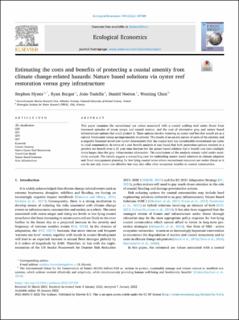| dc.contributor.author | Hynes, Stephen | |
| dc.contributor.author | Burger, Ryan | |
| dc.contributor.author | Tudella, João | |
| dc.contributor.author | Norton, Daniel | |
| dc.contributor.author | Chen, Wenting | |
| dc.date.accessioned | 2022-07-12T11:09:52Z | |
| dc.date.available | 2022-07-12T11:09:52Z | |
| dc.date.created | 2022-05-05T11:02:19Z | |
| dc.date.issued | 2022 | |
| dc.identifier.citation | Ecological Economics. 2022, 194, 107349. | en_US |
| dc.identifier.issn | 0921-8009 | |
| dc.identifier.uri | https://hdl.handle.net/11250/3004661 | |
| dc.description.abstract | This paper examines the recreational use values associated with a coastal walking trail under threat from increased episodes of storm surges and coastal erosion, and the cost of alternative grey and nature based infrastructure options that could protect it. These options involve restoring an oyster reef bar that would act as a natural breakwater versus an impermeable revetment. The results of an on-site survey of users of the amenity and a negative binomial travel cost model demonstrate that the coastal trail has considerable recreational use value to local communities. In terms of a cost benefit analysis it was found that both protection options resulted in a positive net benefit over a 20 year time horizon but the nature based solution had a benefit cost ratio multiple times larger than the grey infrastructure alternative. The conclusions of the analysis remain valid under sensitivity analysis. The results suggest a compelling case for embedding nature based solutions in climate adaption and flood management planning for low lying coastal areas where recreational resources are under threat as it can be not only more cost effective but may also offer other ecosystem benefits to coastal communities. | en_US |
| dc.language.iso | eng | en_US |
| dc.publisher | Elsevier | en_US |
| dc.rights | Navngivelse 4.0 Internasjonal | * |
| dc.rights.uri | http://creativecommons.org/licenses/by/4.0/deed.no | * |
| dc.title | Estimating the costs and benefits of protecting a coastal amenity from climate change-related hazards: Nature based solutions via oyster reef restoration versus grey infrastructure | en_US |
| dc.type | Peer reviewed | en_US |
| dc.type | Journal article | en_US |
| dc.description.version | publishedVersion | en_US |
| dc.rights.holder | © 2022 The Authors | en_US |
| dc.source.pagenumber | 11 | en_US |
| dc.source.volume | 194 | en_US |
| dc.source.journal | Ecological Economics | en_US |
| dc.identifier.doi | 10.1016/j.ecolecon.2022.107349 | |
| dc.identifier.cristin | 2021694 | |
| dc.relation.project | EC/H2020/689518 | en_US |
| cristin.ispublished | true | |
| cristin.fulltext | original | |
| cristin.qualitycode | 1 | |

